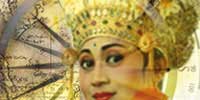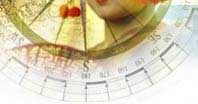|
Ubud has been a "royal town" for over a hundred years. Its princes, who bear the title "Tjokorda" or "Agung" still live in traditional palaces, called "Puris". Be aware, however, that every place called "puri" is not a royal palace. The word has been used quite liberally of late. Also be aware that there is not one palace in Ubud, but many, most of them clustered around the main cross-roads near the Bud market. There are several other "royal" towns in the Bud area, too, with their own palaces, most of which have close family ties to the Bud Tjokordas. A web of connections is maintained by incidental and arranged marriages among the respective offspring of princes in Sayan, Pejeng, Singapadu, Peliatan, and Payangan's puris.
Although the old Balinese feudal system was superseded by the Dutch colonial government more that eighty years ago, the Tjokordas still retain a special role in Ubud society. Many leadership roles, both sacred and secular are held by Tjokordas. They also figure prominently in the local business community, arts institutions, and professional circles. While no formal power is automatically granted to someone because they come from a puri, the Ubud royals still command respect solely on the basis of their heredity. They also command respect from some quarters on the basis of their rather disproportionate wealth.
The palaces have long been the largest landholders in the area. They used to manifest this role in a largely "custodial" way, managing vast tracts of rice-growing land for the benefit of the community and the temples. In recent times, however, with the advent of western models of land ownership, many palaces have developed or sold landholdings to augment their personal wealth--sometimes conspicuously. In pre-colonial Bali, palaces were the primary patrons of art, music, dance and literature. The Ubud palaces consciously continue this tradition. They act as repositories of traditional culture, and develop artistic endeavours throughout the area, much to the benefit of both Ubudians and visitors.
The Tjokordas are no longer the physical embodiment of The State, they are just private citizens, with the same concerns as other private citizens, plus a few more. Accordingly, the Ubud palaces are essentially just family homes, and none have yet been turned into museums of public tourist attractions.
While some of them are fine examples of traditional architecture, none are "historical" in terms of age. In fact, most are pretty new. The oldest Ubud palace was located a little to the east of Pura Dalem Ubud, above the main road. It collapsed in an earthquake early this century, and nothing remains but a flat place with traces of foundation here and there.
List of Ubud Palaces
"Thank you for your support"
| 






